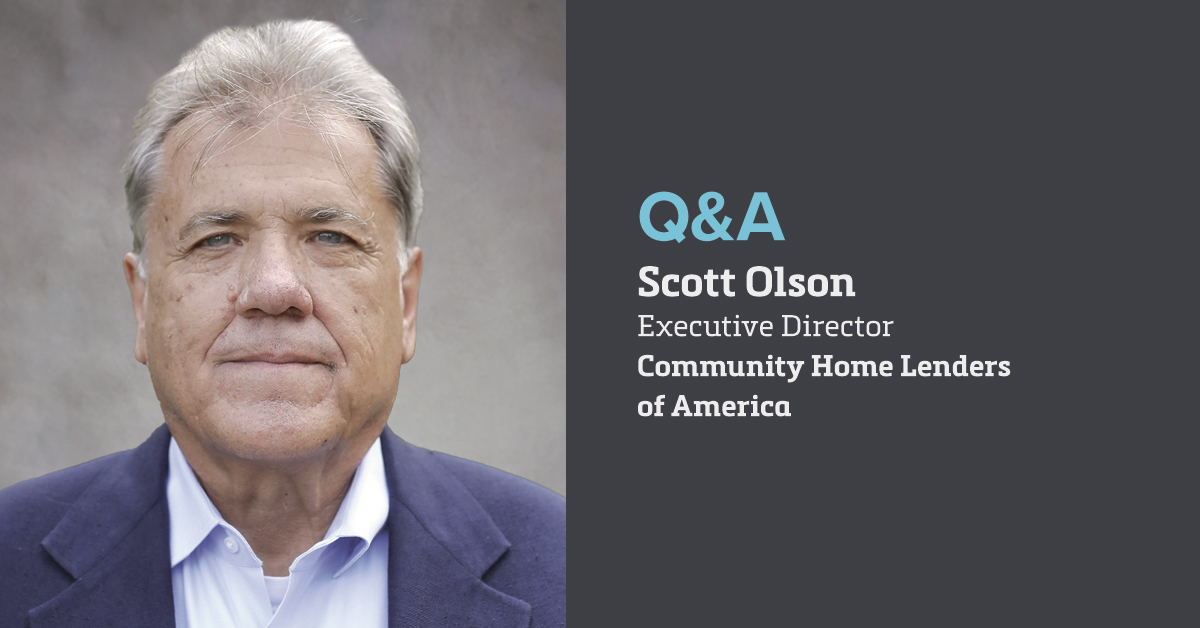It’s no secret that independent mortgage banks (IMBs) have taken on the lion’s share of home lending in the U.S. These institutions originate about two-thirds of all mortgages as well as 90% of all Federal Housing Administration (FHA) and U.S Department of Veterans Affairs (VA) loans, according to a 2022 report from the Community Home Lenders of America (CHLA).
“There’s some tweaking that could be done in terms of the mortgage rates, because we think they’re out of whack.”
CHLA advocates on behalf of the smaller and midsized IMBs, the lenders doing somewhere in the range of hundreds of millions of dollars to tens of billions of dollars in loans per year. These lenders have endured what has turned out to be a difficult year in the mortgage market, said Scott Olson, CHLA’s executive director.
“I think optimism reigns supreme, and it is struggle, but I think we’re looking forward to a better year in 2024,” Olson said.
Olson talked about the challenges his member institutions face and what could brighten the skies. He also talked about last year’s merger between the Community Mortgage Lenders of America (CMLA) and the Community Home Lenders Association, which created the current organization.
How are smaller and midsized community mortgage lenders weathering the current market?
Obviously, the volume has gone down significantly in the last year and a half because the rates have more than doubled. The overall trend is IMBs, over the last 16 months, have had to make job cuts to rightsize and reconfigure their companies. A few have gone out of business, some have merged, but I think our firms are weathering the storm.
What are the other biggest issues facing smaller lenders?
For those that originate Fannie Mae and Freddie Mac loans, we’ve seen concerns on our members’ part about the level of repurchase demands on loans that are performing. Older loans have lower coupon rates. So, if you’re forced to repurchase a loan, you’re not only assuming the risk, but you have a huge loss.
That’s when Fannie and Freddie find something wrong with the loan and make it go back on the lender’s books, right?
We’ve been really clear, if the loan is defective, that’s fine. That’s different. A lot of times we see these are differences in appraisals. It’s not a clear-cut error. It’s the difference of opinion. So, we just think that they’ve been a little bit on the aggressive side.
What’s being done about that?
We’ve been really pleased that the (Federal Housing Finance Agency) director and, to some extent, the (government-sponsored enterprises), have been responsive. We’ve been saying, ‘Look, whatever you feel that the risk is, do this as an indemnification.’ We’ll pay a relatively small fee, which we think represents the risk of what is still a performing loan.
Large banks are shying away from loans on low-cost homes. Are smaller lenders the answer?
The FHA has been trying to look at ways that we can incentivize smaller loans. It’s just harder. Some of the fixed costs of doing loans are going to be the same whether it’s a $90,000 home or a $650,000 loan. I think you’re right: IMBs and particularly smaller community IMBs are really interested in doing this. With volume declining, people are looking for business.
Any bright spots on the horizon?
We’d love to look forward to rates going down. Our members believe that interest rates are about 100 basis points, a full percentage point, over where they should be historically versus comparable bond yields. The Fed’s going to deal with monetary policy overall to control inflation. That’s a good thing. But there’s some tweaking that could be done in terms of the mortgage rates, because we think they’re out of whack. If rates came down, some of the clouds would lift.
What are the lessons that have been learned with last year’s CHLA-CMLA merger?
We probably regret we didn’t do it four years earlier. We’re really a bottom-up organization in the sense that members set the tone. I think we have more clout. The cultures have mixed well. We were pretty similar organizations to begin with.
We just had so many things in the last year that were big priorities that we’ve gotten across the finish line. Cutting FHA premiums, that was big for us. We weighed in to protect smaller members in the promulgation of capital requirements for Ginnie Mae and FHFA. I think we’ve kind of had a banner year. ●






